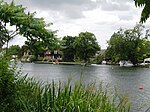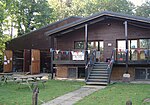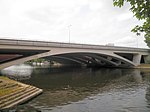Wraysbury and Hythe End Gravel Pits
Sites of Special Scientific Interest in Berkshire

Wraysbury and Hythe End Gravel Pits is a 117.2-hectare (290-acre) biological Site of Special Scientific Interest in Wraysbury in Berkshire. It is part of South West London Waterbodies Ramsar site and Special Protection Area.The site features four former gravel pits and is within the floodplains of the River Thames and the Colne Brook. It is important for the number of bird species it features.
Excerpt from the Wikipedia article Wraysbury and Hythe End Gravel Pits (License: CC BY-SA 3.0, Authors, Images).Wraysbury and Hythe End Gravel Pits
Staines Road,
Geographical coordinates (GPS) Address Nearby Places Show on map
Geographical coordinates (GPS)
| Latitude | Longitude |
|---|---|
| N 51.451 ° | E -0.545 ° |
Address
Staines Road
TW19 5AG
England, United Kingdom
Open on Google Maps









